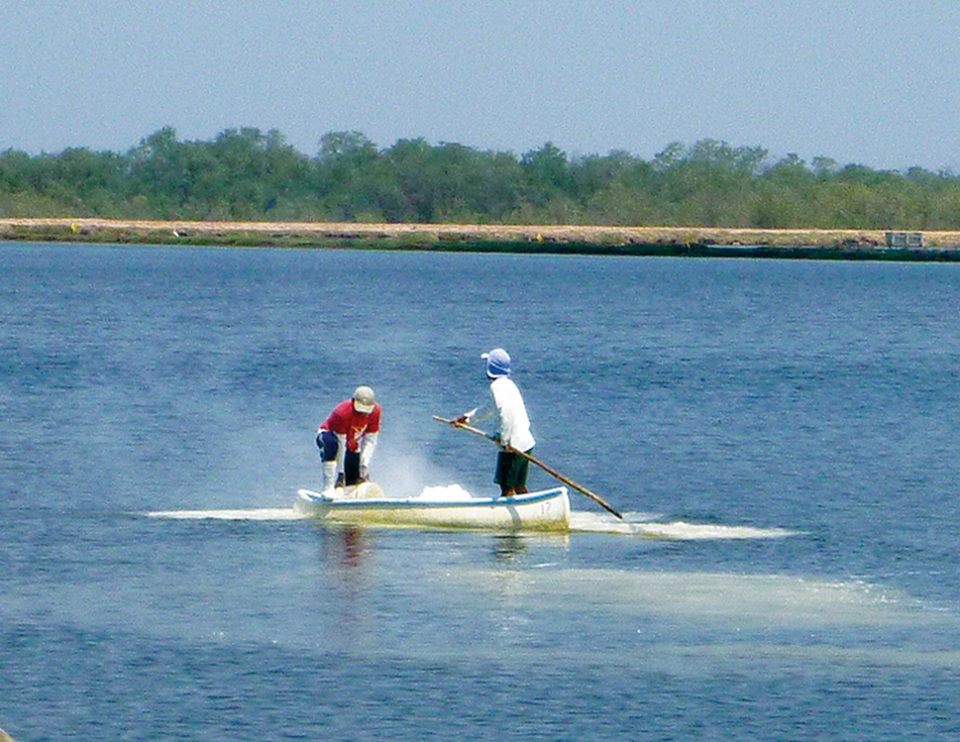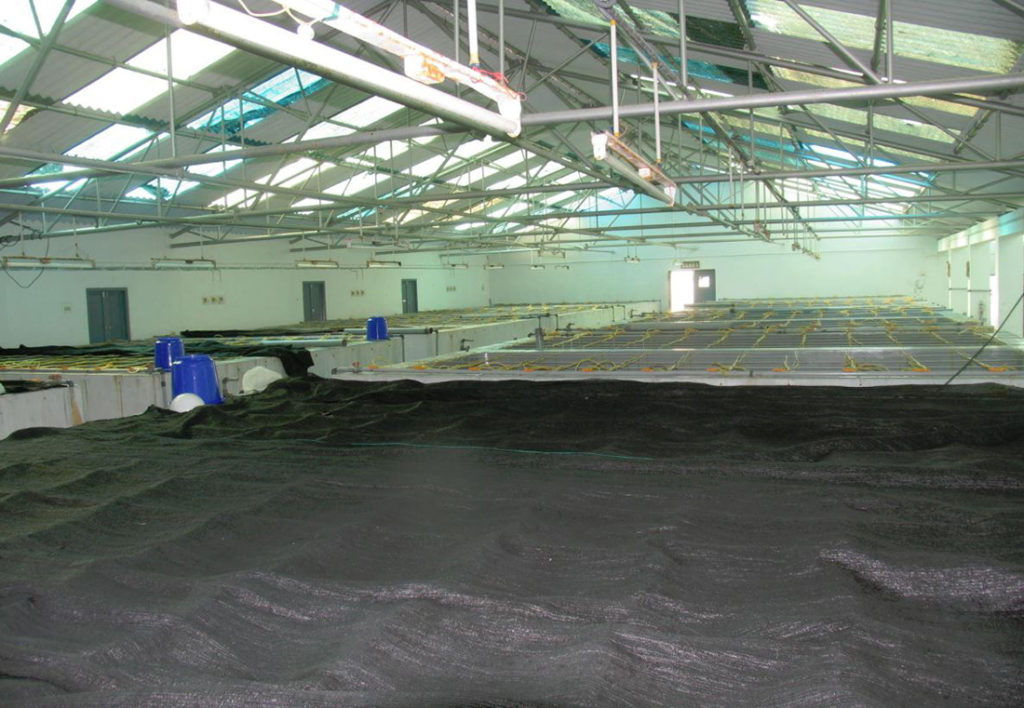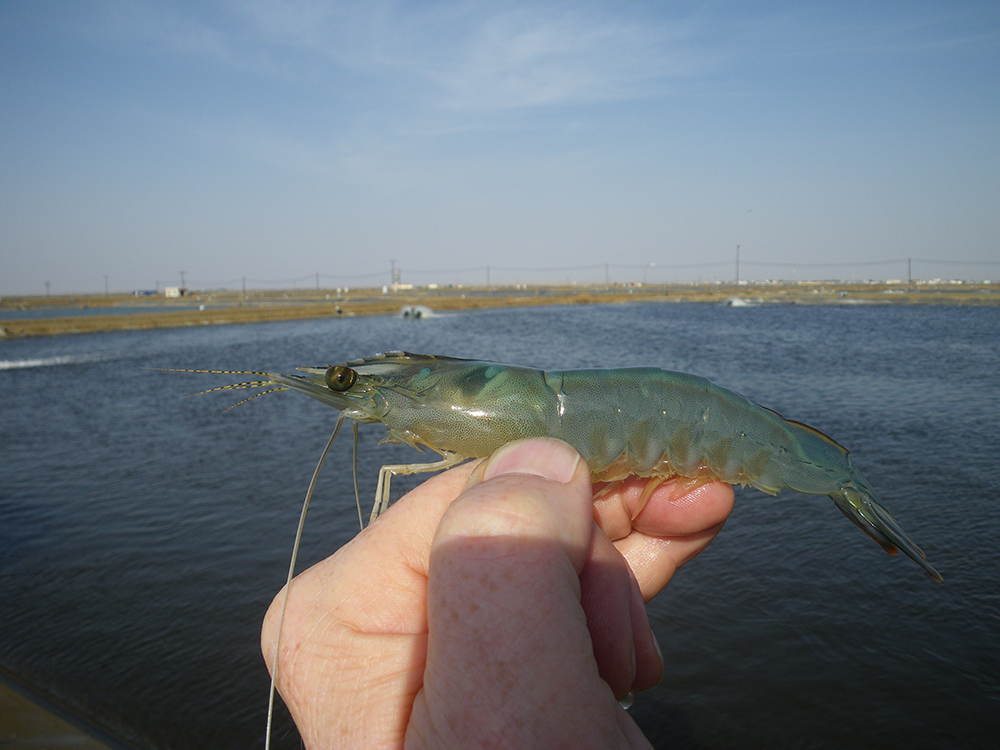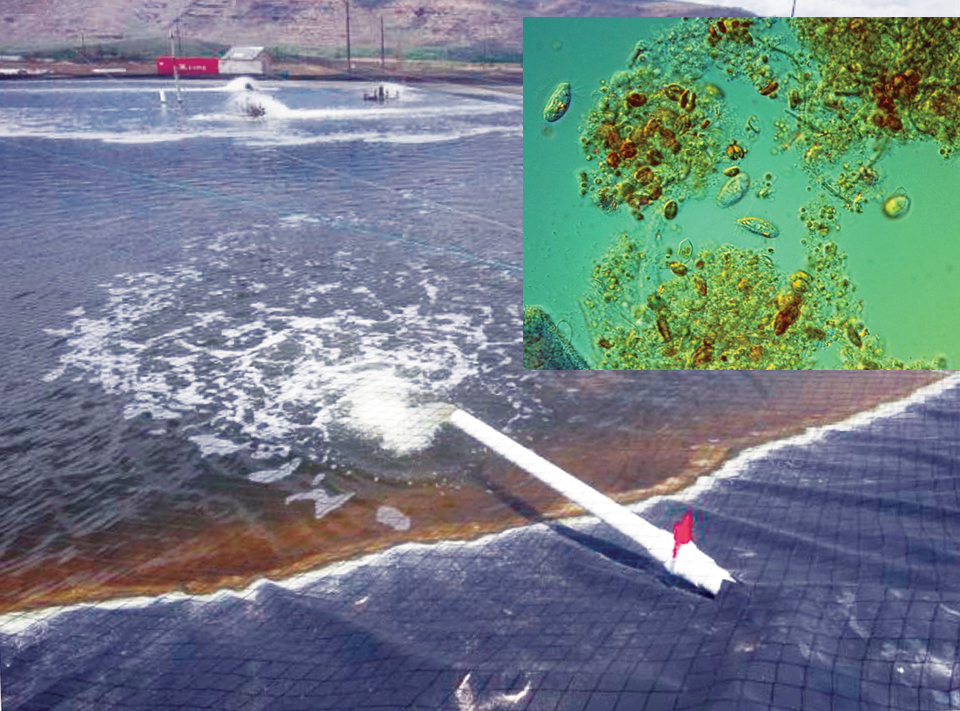Use can be harmful to workers and cause stress to shrimp during an outbreak

Although the application of lime has proven to be beneficial in controlling shrimp diseases like Taura syndrome and white spot syndrome by keeping optimum alkalinity levels, trials conducted at the Fisheries Engineering Faculty of Tumbes University in Peru showed that using lime for controlling vibriosis can be im-practical.
This is based on the minimum inhibitory concentrations (MICs) found for hydrated and quick lime against pathogenic strains of Vibrio parahaemolyticus and V. alginolyticus. For instance, it would require applications of 4,000 kg/ha hydrated lime to control V. alginolyticus and 9,000 kg/ha for V. parahaemolyticus. If applied at such high concentrations, the lime would cause drastic pH changes in pond water and stress the affected shrimp.
Inhibitory concentrations
Research was done to determine the minimum inhibitory concentrations of calcium oxide quick lime and calcium hydroxide hydrated lime against pathogenic strains of Vibrio parahaemolyticus and V. alginolyticus identified in a shrimp farm next to the Tumbes University campus and isolated in agar.
Both types of lime were tested at a pure bacterial concentration of 5 x 103 colony-forming units (CFUs) per mL for an incubation period of 24 hours at 28 degrees-C. Using an adaptation of the standard methods described by the U.S. National Committee for Clinical Laboratory Standards, researchers found MIC values of 30 ppm for calcium oxide use against both V. parahaemolyticus and V. alginolyticus, 900 ppm for calcium hydroxide treatment of V. parahaemolyticus and 400 ppm for control of V. alginolyticus with calcium hydroxide.
Trials were conducted in two phases: an exploratory phase using a wide range of concentrations for both types of lime and a final phase in which more accurate values were obtained (Tables 1-4).
Portal, Inhibitory effects of calcium oxide, Table 1
| Calcium Oxide Concentration | Replicate 1 | Replicate 2 | Replicate 3 | Replicate 4 | Replicate 5 | Rate of Effectiveness |
|---|---|---|---|---|---|---|
| 100 ppm | + | + | + | + | + | 100% |
| 90 ppm | + | + | + | + | + | 100% |
| 80 ppm | + | + | + | + | + | 100% |
| 70 ppm | + | + | + | + | + | 100% |
| 60 ppm | + | + | + | + | + | 100% |
| 50 ppm | + | + | + | + | + | 100% |
| 40 ppm | + | + | + | + | + | 100% |
| 30 ppm | + | + | + | + | + | 100% |
| 20 ppm | + | + | – | – | – | 40% |
| 10 ppm | – | – | – | – | – | 0% |
| 0 ppm | – | – | – | – | – | 0% |
Table 1. Inhibitory effects of calcium oxide against a pathogenic strain of Vibrio parahaemolyticus.
Portal, Inhibitory effects of calcium oxide, Table 2
| Calcium Oxide Concentration | Replicate 1 | Replicate 2 | Replicate 3 | Replicate 4 | Replicate 5 | Rate of Effectiveness |
|---|---|---|---|---|---|---|
| 100 ppm | + | + | + | + | + | 100% |
| 90 ppm | + | + | + | + | + | 100% |
| 80 ppm | + | + | + | + | + | 100% |
| 70 ppm | + | + | + | + | + | 100% |
| 60 ppm | + | + | + | + | + | 100% |
| 50 ppm | + | + | + | + | + | 100% |
| 40 ppm | + | + | + | + | + | 100% |
| 30 ppm | + | + | + | + | + | 100% |
| 20 ppm | + | – | – | – | – | 20% |
| 10 ppm | – | – | – | – | – | 0% |
| 0 ppm | – | – | – | – | – | 0% |
Table 2. Inhibitory effects of calcium oxide against a pathogenic strain of Vibrio alginolyticus.
Portal, Inhibitory effects of calcium hydroxide, Table 3
| Calcium Hydroxide Concentration | Replicate 1 | Replicate 2 | Replicate 3 | Replicate 4 | Replicate 5 | Rate of Effectiveness |
|---|---|---|---|---|---|---|
| 1 ppt | + | + | + | + | + | 100% |
| 900 ppm | + | + | + | + | + | 100% |
| 800 ppm | + | – | – | + | – | 40% |
| 700 ppm | – | – | – | – | – | 0% |
| 600 ppm | – | – | – | – | – | 0% |
| 500 ppm | – | – | – | – | – | 0% |
| 400 ppm | – | – | – | – | – | 0% |
| 300 ppm | – | – | – | – | – | 0% |
| 200 ppm | – | – | – | – | – | 0% |
| 100 ppm | – | – | – | – | – | 0% |
| 0 ppm | – | – | – | – | – | 0% |
Table 3. Inhibitory effects of calcium hydroxide against a pathogenic strain of Vibrio parahaemolyticus.
Portal, Inhibitory effects of calcium hydroxide, Table 4
| Calcium Hydroxide Concentration | Replicate 1 | Replicate 2 | Replicate 3 | Replicate 4 | Replicate 5 | Rate of Effectiveness |
|---|---|---|---|---|---|---|
| 1 ppt | + | + | + | + | + | 100% |
| 900 ppm | + | + | + | + | + | 100% |
| 800 ppm | + | + | + | + | + | 100% |
| 700 ppm | + | + | + | + | + | 100% |
| 600 ppm | + | + | + | + | + | 100% |
| 500 ppm | + | + | + | + | + | 100% |
| 400 ppm | + | + | + | + | + | 100% |
| 300 ppm | – | – | – | – | – | 0% |
| 200 ppm | – | – | – | – | – | 0% |
| 100 ppm | – | – | – | – | – | 0% |
| 0 ppm | – | – | – | – | – | 0% |
Table 4. Inhibitory effects of calcium hydroxide against a pathogenic strain of Vibrio alginolyticus.
Both quick and hydrated limes used at their MICs showed inhibitory effects that worked through a sudden pH increase of the medium. The inhibitory effects occurred at pH levels above 9.5 for quick lime and over 9.0 for hydrated lime. When these MIC values for both types of lime were applied in pond water, it was found that the action of quick lime lasted for 10 minutes, and the action of hydrated lime lasted for 15 minutes.
Vibriosis management?
Some Latin-American shrimp farmers have reported beneficial results in the use of hydrated lime against pathogenic Vibrio attacks at concentrations of 75-100 kg/ha based on the “disinfectant power” of such concentrations. However, the authors have visited many shrimp farms in Latin America that have had uncertain results with the application of these liming rates. Farmers who limed at 75-100 kg/ha eventually had to use other methods, such as the application of probiotics or antibiotics in feed, to overcome Vibrio outbreaks.
Also in this study, quick and hydrated limes were applied at 75 kg/ha to tanks containing pond water with the pathogenic Vibrio strains tested for MICs. Results showed the applications were not successful in controlling the bacterial populations, even under optimal water parameters (Table 5).
Portal, Pond water parameters, Table 5
| Pond Water Parameter | Before Lime Application | One Hour After Application Control | One Hour After Application Calcium Oxide | One Hour After Application Calcium Hydroxide |
|---|---|---|---|---|
| pH | 8.5 | 8.6 | 9.8 | 9.5 |
| Temperature (° C) | 30 | 30.5 | 30.6 | 30.5 |
| Dissolved oxygen (mg/L) | 5.5 | 5.4 | 5.4 | 5.6 |
| Total alkalinity (ppm) | 158 | 153 | 159 | 162 |
| Total hardness (ppm) | 3,560 | 3,550 | 3,540 | 3,550 |
Perspectives
Although this study found that a smaller amount (300 kg/ha) of quick lime was required for inhibiting Vibrio species than the 4,000 and 9,000 kg/ha of hydrated lime needed, the use of quick lime is not recommended because it can be harmful to workers who apply it. The sudden rise in water pH quick lime generates can also cause stress to shrimp during a Vibrio outbreak.
(Editor’s Note: This article was originally published in the July/August 2013 print edition of the Global Aquaculture Advocate.)
Authors
-
Ing. Juan Portal
Technical Assistance Manager
Nicovita – Alicorp SAA
Av. Panamericana Norte
Km. 1272
Tumbes, Peru[101,112,46,109,111,99,46,112,114,111,99,105,108,97,64,99,97,116,114,111,112,106]
-
Dr. Carlos A. Ching
Aquaculture Manager
Nicovita – Alicorp SAA
Callao, Lima, Peru
Tagged With
Related Posts

Health & Welfare
A holistic management approach to EMS
Early Mortality Syndrome has devastated farmed shrimp in Asia and Latin America. With better understanding of the pathogen and the development and improvement of novel strategies, shrimp farmers are now able to better manage the disease.

Health & Welfare
A study of Zoea-2 Syndrome in hatcheries in India, part 3
In this third and final part, authors present recommendations to help reduce the incidence of Zoea-2 Syndrome, which is not caused by any known infectious agents in P. vannamei hatcheries in India.

Health & Welfare
EHP a risk factor for other shrimp diseases
Laboratory challenges and a case-control study were used to determine the effects of EHP infection on two Vibrio diseases: acute hepatopancreatic necrosis disease (AHPND) and septic hepatopancreatic necrosis (SHPN).

Health & Welfare
Do current shrimp practices favor EMS?
After refilling ponds, surviving microorganisms – including Vibrio parahaemolyticus, which causes EMS in shrimp – may benefit from the availability of nutrients in sediment and water and lack of competing microorganisms.


